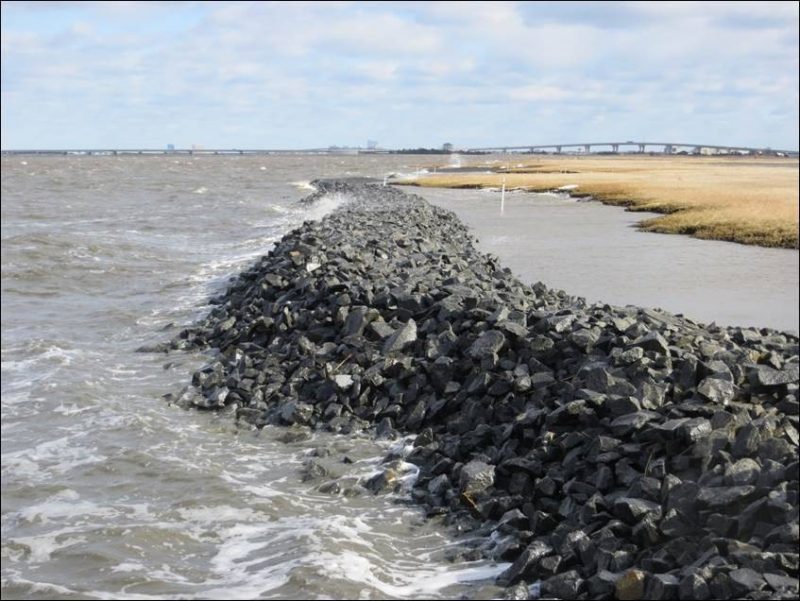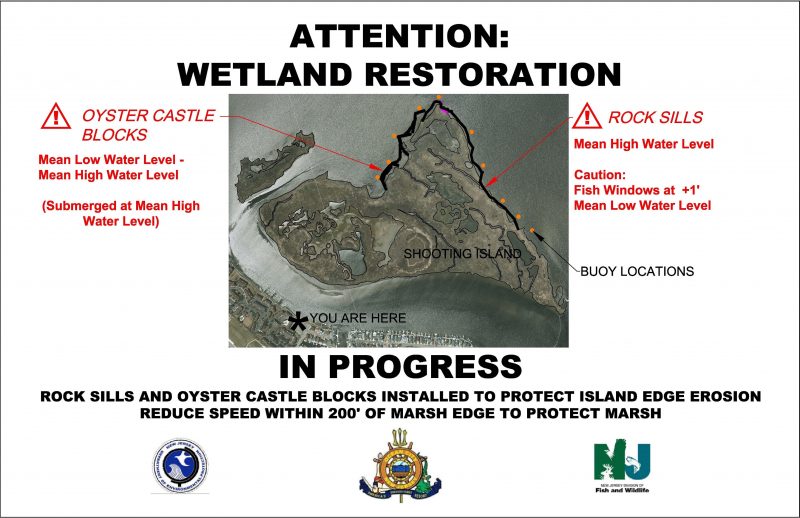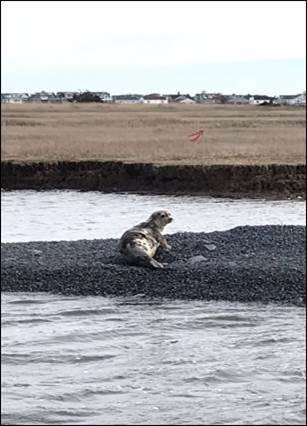A "Living Shoreline" continues to take shape on Shooting Island in Ocean City with a restoration project. (Photo courtesy of ACT Engineers)
 By MADDY VITALE
A project to restore Shooting Island, a living shoreline in Ocean City, is not only the longest of its kind in the state, but it is right on schedule with the first phase completed.
Mayor Jay Gillian and other officials say the wetlands restoration plan will create coastal resiliency, providing an environment for the wildlife to continue to thrive and to reduce the storm impacts along the bayfront.
“The mayor is grateful to the state Department of Environmental Protection, the National Fish and Wildlife Foundation, the National Marine Fisheries Service and the U.S. Army Corps of Engineers for their partnership and financial support in this groundbreaking project,” said Public Information Officer Doug Bergen. “If all goes well, the new living shoreline should provide both a buffer against storms and a habitat for birds and marine life.”
https://www.youtube.com/watch?v=x4vDyHGUDv4&t=21s
Charter Contracting, of Boston, installed 2,700 linear feet of rock sill to protect existing marsh and allow for further development of marsh on the island; and 1,450 linear feet of oyster habitat along the northern and western edges of the island. The oyster “castles” are manmade block-like structures, like Legos, that provide the ideal habitat for shellfish, according to Ocean City officials.
The sill functions as protection for the Shooting Island wetlands and will absorb energy from the waves and currents. The oyster habitat blocks were spaced to promote the flow of tidal water between the marsh and bay, officials said.
“Everything went really smoothly with the project. The contractor completed it ahead of time and it certainly has met all of our expectations on the beginning of the restoration of the island coming together,” explained Carol Beske, founder of ACT Engineers, the city’s dredging consultant.
Beske said many agencies have worked together to make this possible.
"We have had full cooperation from various agencies,” Beske said. “I just give a great deal of credit to Ocean City and the mayor and administration for what they have done to tackle this whole dredging issue. They had the foresight to know this is part of solving (storm problems) in their long-range plans. To me, their foresight and commitment has been phenomenal.”
While there have been other projects in the state to restore living shorelines, and some are underway, Beske said none are to this level.
She noted that it is amazing to see the abundance of wildlife on Shooting Island, which includes birds and even harbor seals. A main part of the plan was to provide a new habitat for birds, marine life and other coastal species.
“We’ve even had harbor seals sitting on the rocks sunning themselves and all types of birds,” Beske said. “And the restoration of that island definitely does protect a portion of Ocean City.”
By MADDY VITALE
A project to restore Shooting Island, a living shoreline in Ocean City, is not only the longest of its kind in the state, but it is right on schedule with the first phase completed.
Mayor Jay Gillian and other officials say the wetlands restoration plan will create coastal resiliency, providing an environment for the wildlife to continue to thrive and to reduce the storm impacts along the bayfront.
“The mayor is grateful to the state Department of Environmental Protection, the National Fish and Wildlife Foundation, the National Marine Fisheries Service and the U.S. Army Corps of Engineers for their partnership and financial support in this groundbreaking project,” said Public Information Officer Doug Bergen. “If all goes well, the new living shoreline should provide both a buffer against storms and a habitat for birds and marine life.”
https://www.youtube.com/watch?v=x4vDyHGUDv4&t=21s
Charter Contracting, of Boston, installed 2,700 linear feet of rock sill to protect existing marsh and allow for further development of marsh on the island; and 1,450 linear feet of oyster habitat along the northern and western edges of the island. The oyster “castles” are manmade block-like structures, like Legos, that provide the ideal habitat for shellfish, according to Ocean City officials.
The sill functions as protection for the Shooting Island wetlands and will absorb energy from the waves and currents. The oyster habitat blocks were spaced to promote the flow of tidal water between the marsh and bay, officials said.
“Everything went really smoothly with the project. The contractor completed it ahead of time and it certainly has met all of our expectations on the beginning of the restoration of the island coming together,” explained Carol Beske, founder of ACT Engineers, the city’s dredging consultant.
Beske said many agencies have worked together to make this possible.
"We have had full cooperation from various agencies,” Beske said. “I just give a great deal of credit to Ocean City and the mayor and administration for what they have done to tackle this whole dredging issue. They had the foresight to know this is part of solving (storm problems) in their long-range plans. To me, their foresight and commitment has been phenomenal.”
While there have been other projects in the state to restore living shorelines, and some are underway, Beske said none are to this level.
She noted that it is amazing to see the abundance of wildlife on Shooting Island, which includes birds and even harbor seals. A main part of the plan was to provide a new habitat for birds, marine life and other coastal species.
“We’ve even had harbor seals sitting on the rocks sunning themselves and all types of birds,” Beske said. “And the restoration of that island definitely does protect a portion of Ocean City.”
 The project is creating a buffer from storms on the bayfront and restores wetlands.
Since 1978, Shooting Island, which is off Tennessee Avenue and is uninhabited, has seen significant degradation. Its shoreline has receded nearly 60 feet. With the project, more than 150 acres of tidal wetlands will be restored.
If there was nothing done, officials said the island would be gone by 2100.
Officials noted that the next phases of the restoration project include filling in between the rock sill and the oyster habitats, applying dredge materials and restoring and recreating the wetlands using some dredge materials. A $2.2 million grant from the National Fish and Wildlife Foundation allows the work crews to experiment with ways to “create and stabilize wetlands.”
The permit was issued to Ocean City in partnership with the U.S. Army Corps of Engineers, N.J Department of Environmental Protection, U.S. Department of Interior, National Fish and Wildlife Foundation and National Marine Fisheries Service. The first phase of the project was completed in late spring, ahead of schedule and under budget.
The project is creating a buffer from storms on the bayfront and restores wetlands.
Since 1978, Shooting Island, which is off Tennessee Avenue and is uninhabited, has seen significant degradation. Its shoreline has receded nearly 60 feet. With the project, more than 150 acres of tidal wetlands will be restored.
If there was nothing done, officials said the island would be gone by 2100.
Officials noted that the next phases of the restoration project include filling in between the rock sill and the oyster habitats, applying dredge materials and restoring and recreating the wetlands using some dredge materials. A $2.2 million grant from the National Fish and Wildlife Foundation allows the work crews to experiment with ways to “create and stabilize wetlands.”
The permit was issued to Ocean City in partnership with the U.S. Army Corps of Engineers, N.J Department of Environmental Protection, U.S. Department of Interior, National Fish and Wildlife Foundation and National Marine Fisheries Service. The first phase of the project was completed in late spring, ahead of schedule and under budget.
 A harbor seal suns itself on the rocks.
A harbor seal suns itself on the rocks.